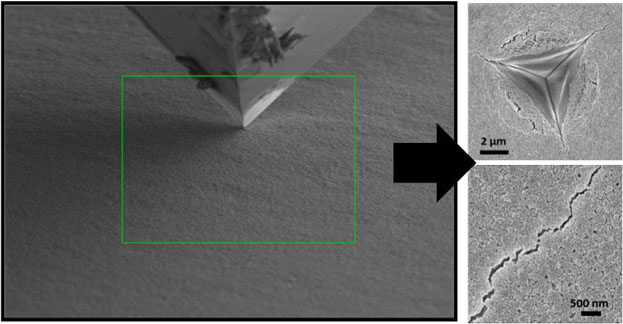Nanomechanics: Exploring the Mechanical Behavior of Materials at the Nanoscale
What is Nanomechanics?
Nanomechanics is a branch of nanotechnology that focuses on the study of mechanical properties and behavior of materials at the nanoscale. It involves investigating how materials respond to forces, deformations, and other mechanical stimuli when their dimensions are reduced to the nanometer range. Nanomechanics plays a crucial role in understanding the fundamental mechanisms governing the strength, stiffness, and durability of nanomaterials and nanostructures.

Importance of Nanomechanics
Understanding the mechanical behavior of materials at the nanoscale is crucial for several reasons:
- Material Design: Nanomechanics provides insights into the structure-property relationships of nanomaterials, enabling the design of materials with tailored mechanical properties for specific applications.
- Reliability and Durability: By studying the mechanical behavior of nanomaterials under various conditions, researchers can assess their reliability and durability, which is essential for the development of robust and long-lasting nanodevices and nanostructures.
- Fundamental Understanding: Nanomechanics contributes to the fundamental understanding of the physical principles governing the mechanical behavior of materials at the nanoscale, which can differ significantly from their bulk counterparts.
Experimental Techniques in Nanomechanics
Several experimental techniques are employed to study the mechanical properties of nanomaterials:
Nanoindentation
Nanoindentation is a widely used technique that involves pressing a sharp indenter tip into a material surface at the nanoscale. By measuring the applied load and the resulting indentation depth, researchers can determine the hardness and elastic modulus of the material. Nanoindentation allows for the characterization of mechanical properties at specific locations on a sample, making it suitable for studying heterogeneous materials and thin films.
Atomic Force Microscopy (AFM)
Atomic Force Microscopy (AFM) is a versatile tool for nanomechanical characterization. In addition to imaging surface topography, AFM can be used to measure forces and deformations at the nanoscale. Techniques such as force-distance curves and nanoindentation using AFM tips enable the determination of mechanical properties like adhesion, stiffness, and viscoelasticity.
In Situ Electron Microscopy
In situ electron microscopy techniques, such as in situ transmission electron microscopy (TEM) and in situ scanning electron microscopy (SEM), allow for real-time observation of the mechanical behavior of nanomaterials under applied stress or strain. These techniques provide valuable insights into the deformation mechanisms, fracture behavior, and structural changes occurring at the nanoscale.
Nanomechanical Phenomena
Nanomechanics encompasses various phenomena that govern the mechanical behavior of materials at the nanoscale:
Size Effects
Size effects refer to the observed changes in mechanical properties as the dimensions of a material are reduced to the nanoscale. For example, many nanomaterials exhibit enhanced strength and hardness compared to their bulk counterparts due to the increased surface-to-volume ratio and the reduced prevalence of defects at the nanoscale.
Interfacial Effects
Interfaces play a significant role in the mechanical behavior of nanomaterials. The high surface-to-volume ratio of nanomaterials results in a greater influence of interfacial effects on their mechanical properties. Understanding and controlling interfacial interactions is crucial for optimizing the mechanical performance of nanocomposites and multilayered nanostructures.
Deformation Mechanisms
Nanomechanics investigates the unique deformation mechanisms that operate at the nanoscale. These mechanisms can differ from those observed in bulk materials due to the limited number of atoms and the influence of surface effects. Examples include dislocation nucleation and propagation, grain boundary sliding, and twinning.
Applications of Nanomechanics
Nanomechanics has numerous applications across various fields:
Nanoelectromechanical Systems (NEMS)
Nanomechanics plays a crucial role in the development of nanoelectromechanical systems (NEMS), which are miniaturized devices that combine electrical and mechanical components at the nanoscale. NEMS find applications in sensing, actuation, and signal processing, and their performance relies on the precise control and understanding of nanomechanical behavior.
Material Characterization
Nanomechanical techniques are valuable tools for characterizing the mechanical properties of various materials, including thin films, coatings, and nanostructured materials. This characterization is essential for quality control, material selection, and performance optimization in industries such as microelectronics, aerospace, and biomedicine.
Biomechanics
Nanomechanics finds applications in the field of biomechanics, where it is used to study the mechanical behavior of biological materials and structures at the nanoscale. This includes investigating the mechanical properties of individual cells, proteins, and biomolecules, which is crucial for understanding biological processes and developing novel biomedical devices and therapies.
Challenges and Future Perspectives
Despite the significant advancements in nanomechanics, several challenges remain. One of the main challenges is the accurate measurement and interpretation of nanomechanical properties, as the small scales involved can introduce uncertainties and artifacts. The development of standardized testing protocols and the improvement of measurement techniques are ongoing efforts in the field.
Future research in nanomechanics will focus on the development of advanced experimental techniques and computational methods to probe the mechanical behavior of nanomaterials with higher resolution and accuracy. The integration of nanomechanics with other fields, such as materials science, physics, and biology, will lead to the discovery of novel nanomechanical phenomena and the design of multifunctional nanomaterials and nanodevices.
Further Reading
National Science Review, Nanomechanics of graphene
Journal of the Mechanical Behavior of Biomedical Materials, A methodological framework for nanomechanical characterization of soft biomaterials and polymers
